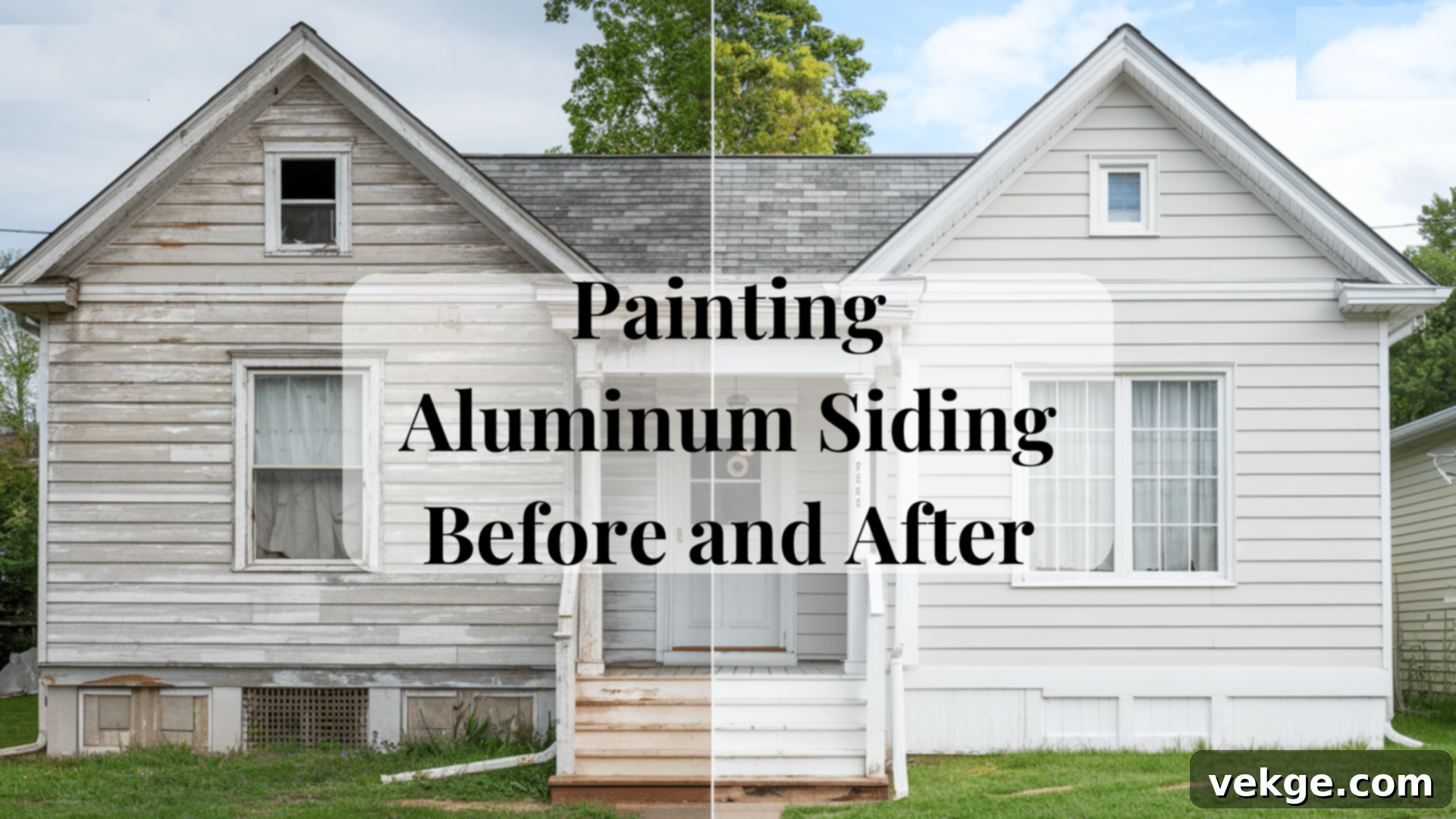Transform Your Home’s Exterior: The Ultimate Guide to Painting Aluminum Siding for Lasting Beauty
Is your home’s aluminum siding looking tired, faded, or simply outdated? Instead of costly replacement, consider a powerful and budget-friendly alternative: painting. A fresh coat of paint can dramatically revitalize your home’s appearance, boosting curb appeal and providing a renewed layer of protection against the elements. With the right techniques and materials, you can achieve a professional-looking finish that will make your house look brand new.
This comprehensive guide will walk you through everything you need to know about painting aluminum siding. We’ll explore the undeniable benefits, showcase inspiring before-and-after transformations, provide a detailed step-by-step process, and share expert tips to ensure a flawless, long-lasting result. Get ready to embark on a home improvement journey that’s both rewarding and surprisingly affordable!
What is Aluminum Siding and Why Paint It?
Aluminum siding is a popular exterior cladding material known for its lightweight nature and impressive weather resistance. First introduced in the 1940s, it quickly gained traction for its durability, low maintenance requirements, and ability to mimic other materials like wood.
While aluminum siding is indeed tough and designed to last, years of relentless exposure to sunlight, rain, snow, and fluctuating temperatures can take a toll. Over time, its original factory finish can fade, chalk (a powdery residue forms on the surface), or simply lose its vibrant luster. This natural degradation can leave your home looking neglected and dated.
Painting aluminum siding offers a powerful two-fold solution: it not only restores and refreshes its aesthetic appeal but also adds a vital protective layer. This new coating acts as a shield against further UV damage, moisture intrusion, and oxidation, effectively extending the lifespan of your existing siding by many years. The process itself is surprisingly straightforward, requiring proper preparation and the application of quality exterior paints. By undertaking this project, homeowners can achieve a significant exterior makeover without the substantial financial outlay and disruption associated with a full siding replacement. A well-executed paint job can easily add another 5-10 years of life to your aluminum siding, all while demanding minimal ongoing maintenance.
Aluminum Siding Before and After: Witness the Beautiful Transformations
One of the most compelling reasons to paint aluminum siding is the dramatic visual impact it delivers. Even the most weathered and tired-looking siding can be transformed into a stunning, fresh facade. These before-and-after examples demonstrate the incredible potential of a quality paint job to completely redefine a home’s curb appeal.
Faded Gray to Fresh White: A Classic Revival
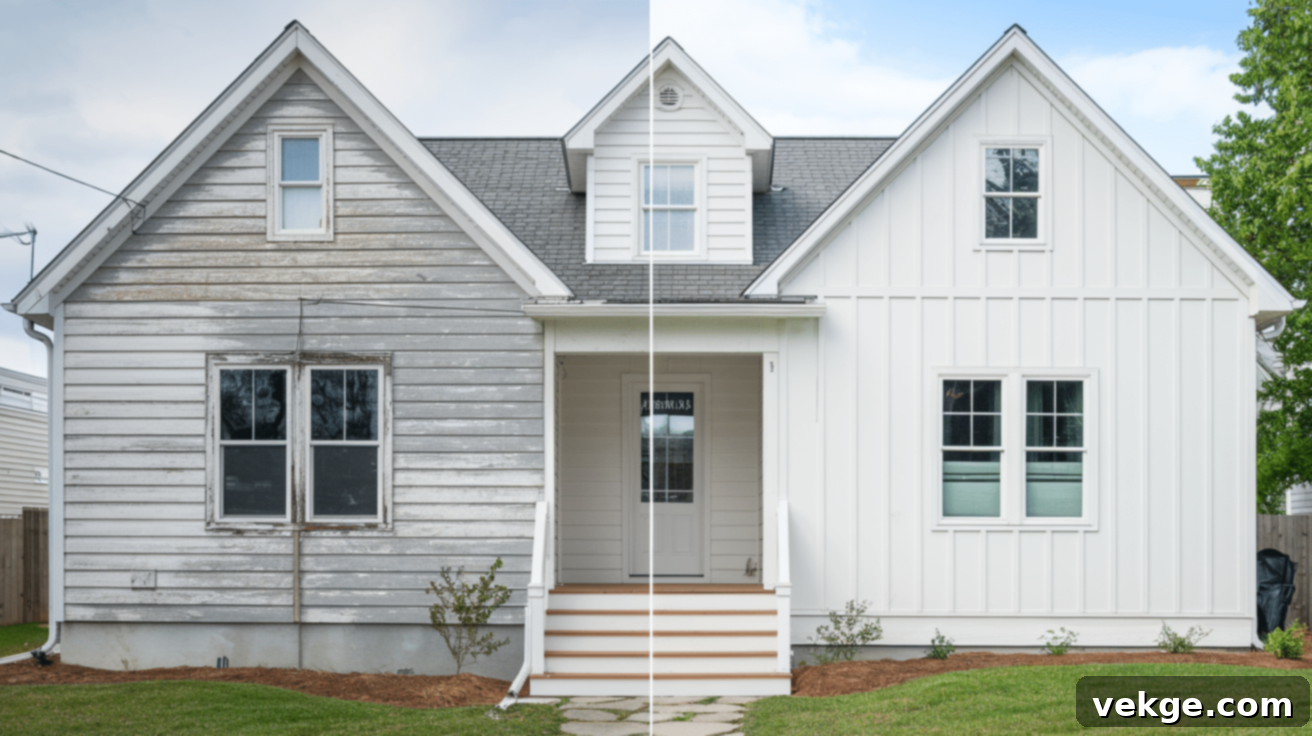
Changing from a dull, weathered gray aluminum siding to a crisp, bright white creates an astonishing contrast and instant modernization. This timeless color choice not only brightens the home but also reflects sunlight, helping to keep interiors cooler and significantly enhancing its curb appeal.
Before:
The original aluminum siding had succumbed to years of environmental exposure, fading into a drab, chalky gray. Its once-vibrant tone was replaced by a tired, lackluster appearance that made the home seem neglected. Touching the surface would leave a visible chalky residue, indicating significant material degradation and a complete loss of its original protective qualities.
After:
Following a meticulous pressure washing to eliminate all built-up grime, mildew, and chalking, the siding received a high-quality metal primer. Subsequently, two coats of premium acrylic exterior paint in a brilliant white were applied. The result is a stunning transformation: a crisp, clean finish that reflects light beautifully, giving the house a contemporary, immaculate look that truly stands out in the neighborhood.
Chipped Paint to Smooth Finish: Restoring Integrity
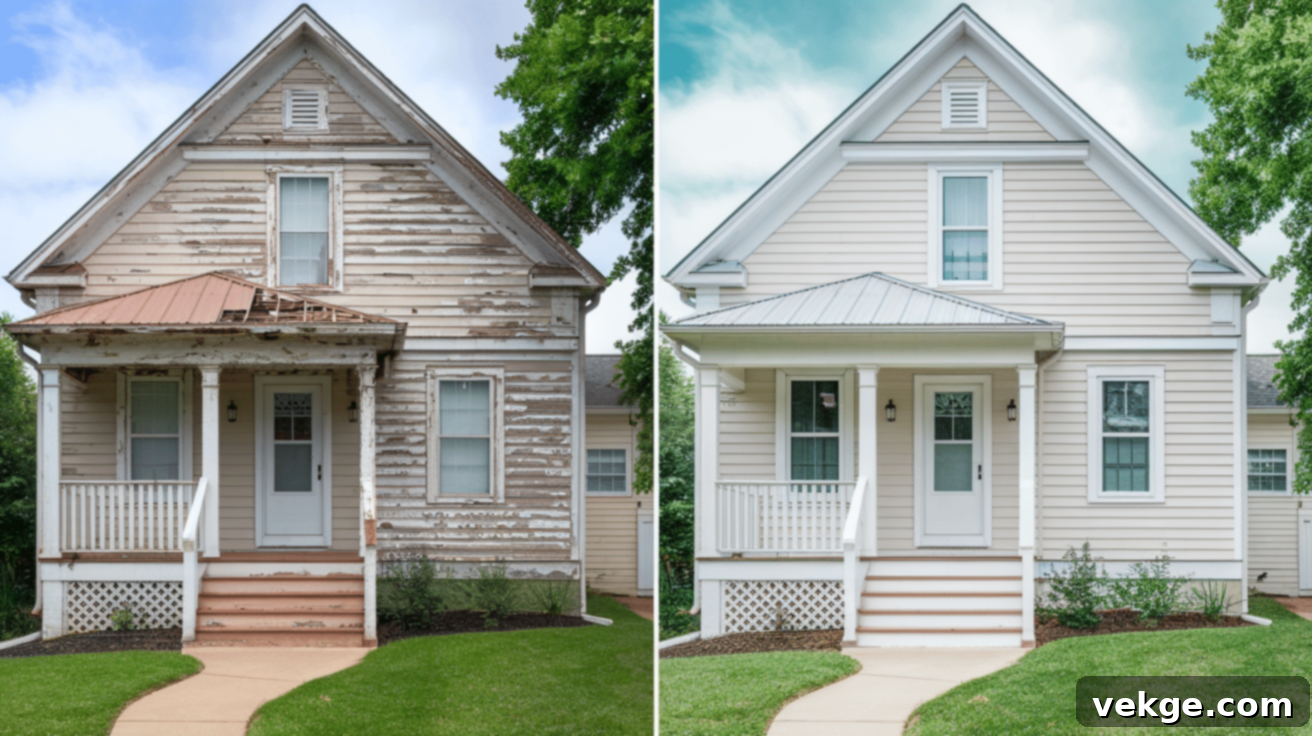
Restoring chipped and peeling aluminum siding is one of the most satisfying transformations. This project not only addresses aesthetic imperfections but also provides crucial protection, sealing vulnerable exposed metal and creating a uniform, weather-resistant surface that appears professionally installed.
Before:
The aluminum siding was plagued by extensive peeling and chipped paint, exposing the underlying metal and creating an unsightly appearance. These flaws not only detracted from the home’s overall look but also left the aluminum susceptible to oxidation, corrosion, and further weather-related damage. The uneven, textured surface cast harsh shadows, further emphasizing the deterioration.
After:
The restoration began with the careful scraping of all loose paint and thorough sanding of rough edges to ensure a perfectly smooth base. After a comprehensive cleaning, a high-adhesion primer was applied, crucial for ensuring proper paint bonding. Two subsequent coats of premium exterior paint created an impeccably smooth, uniform finish, completely erasing all signs of previous damage. The home now boasts a cohesive, well-maintained exterior that significantly enhances its curb appeal and offers renewed protection.
Weathered to Vibrant: A Bold New Identity
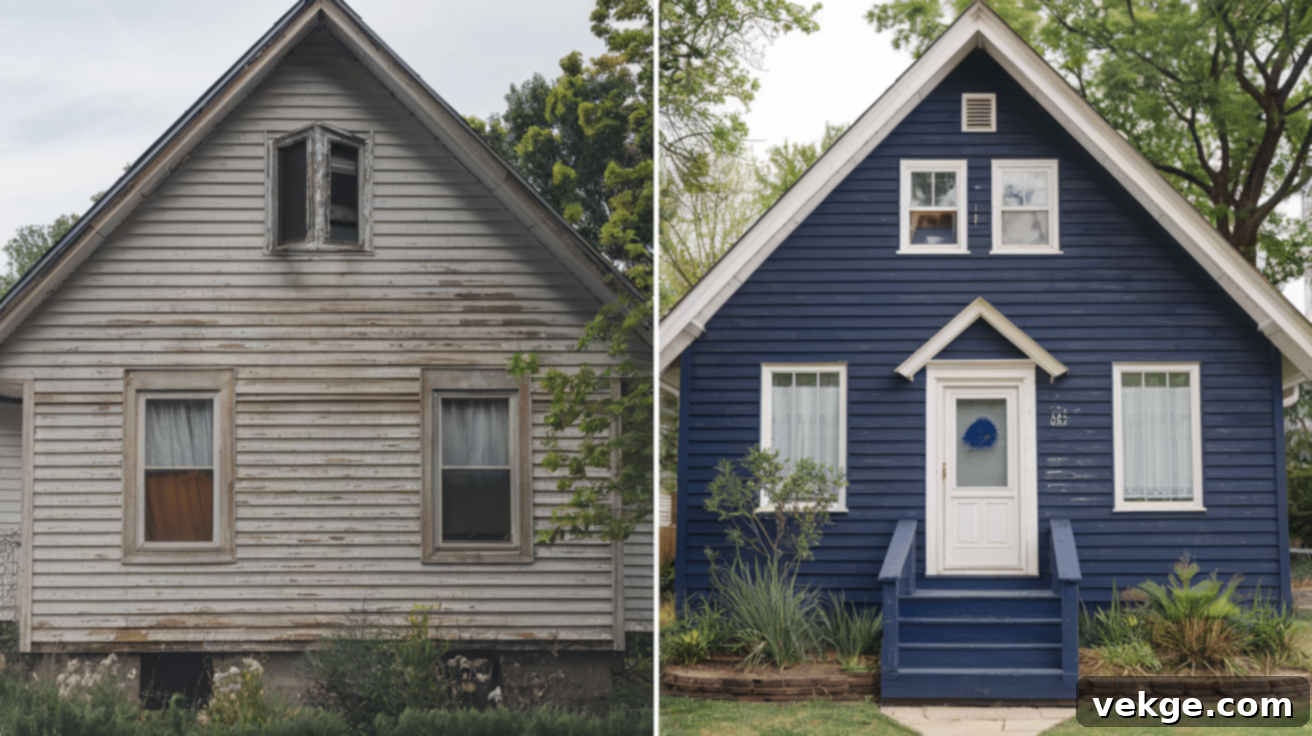
Converting weathered, lackluster aluminum siding into a vibrant, rich color delivers maximum visual impact. This daring transformation uses deep, saturated hues to completely reimagine a home’s exterior character, providing both a fresh aesthetic and enhanced protection against environmental wear.
Before:
Years of sun and rain had left the siding with a tired, faded, and weathered appearance. The surface looked rough and inconsistent, with noticeable signs of neglect that diminished the home’s overall attractiveness. Dark spots from mildew and environmental buildup further contributed to an unkempt and uninviting look.
After:
After thorough cleaning and light sanding to prepare the surface, a specialized metal primer was applied to create the ideal foundation for the new color. The homeowners boldly chose a rich navy blue, a decision that completely transformed the home’s identity. This deep, vibrant color now gives the house a distinctive, upscale appearance that harmonizes beautifully with its surrounding landscape, turning heads with its fresh, modern appeal.
Beige to Earthy Tones: Harmonizing with Nature
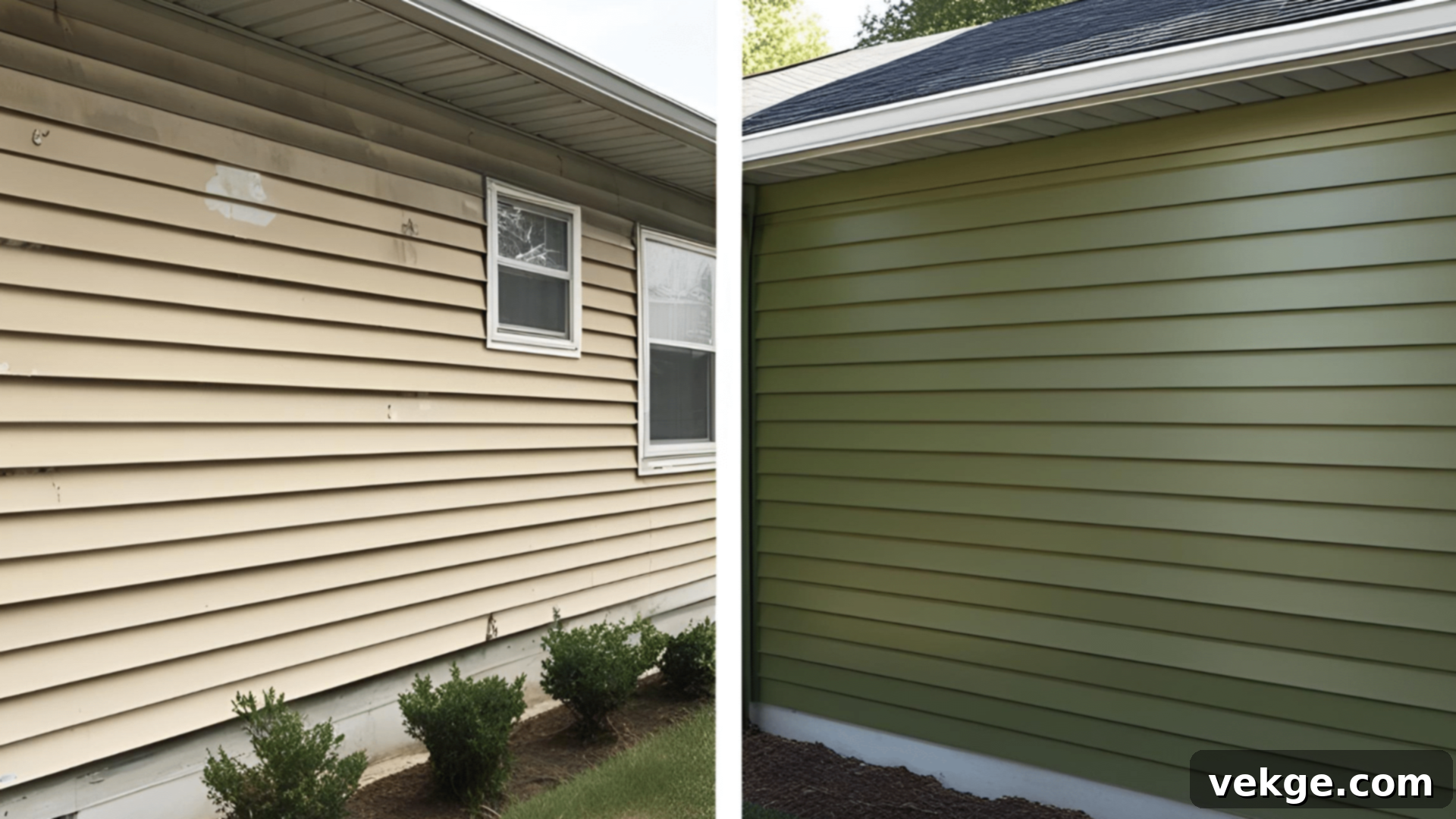
Transitioning from faded beige aluminum siding to rich, earthy tones creates a natural, grounded aesthetic. This change profoundly improves the home’s architectural details and fosters harmony with the surrounding landscape, making the home appear more custom-designed and thoughtfully integrated.
Before:
The original beige aluminum siding had long lost its appeal, appearing outdated and washed out. The once-warm tone had faded into an uneven, lifeless shade, devoid of character, making the house look neglected and old-fashioned. This drab color did little to highlight the home’s unique architectural features, causing it to blend unremarkably into its surroundings.
After:
A comprehensive cleaning removed years of built-up grime, followed by the application of a high-quality primer. The homeowners then selected a warm olive green that perfectly complements the natural landscape. This rich, earthy tone imbued the home with a contemporary yet timeless elegance, emphasizing its constructive details and creating a welcoming and inviting presence that feels custom and well-loved.
Yellowed to Bright White: A Sparkling Rejuvenation
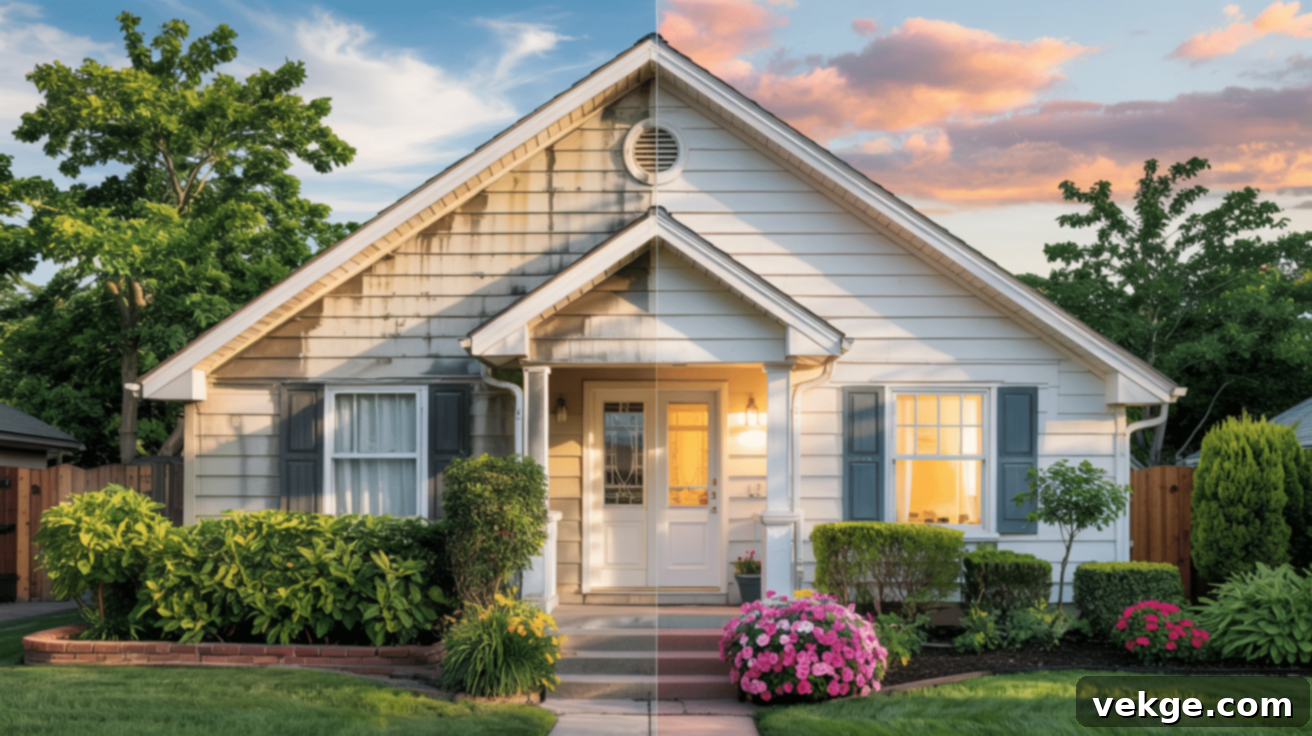
Revitalizing yellowed, stained aluminum siding with bright white paint delivers a remarkable rejuvenation. This classic change instantly modernizes aging homes, creating a clean, fresh appeal that makes the property look recently renovated rather than merely repainted, enhancing its perceived value.
Before:
The white siding had become dull, yellowed by age, and marred by dirt and stains. Mildew spots and an overall lack of brightness contributed to an unkempt appearance, significantly diminishing the home’s visual appeal within the neighborhood. The dingy surface absorbed light rather than reflecting it, giving the home a gloomy and unwelcoming facade.
After:
After thoroughly power washing to eliminate all stains, dirt, and mildew, a specialized mold-resistant primer was applied to prevent any future growth. Two coats of premium glossy white paint completely revitalized the home’s exterior. The bright, reflective finish now beautifully catches the sunlight, giving the house a pristine, fresh look that makes it appear newly installed, rather than simply repainted, offering a stunning transformation and renewed elegance.
How to Paint Aluminum Siding: A Step-by-Step Guide
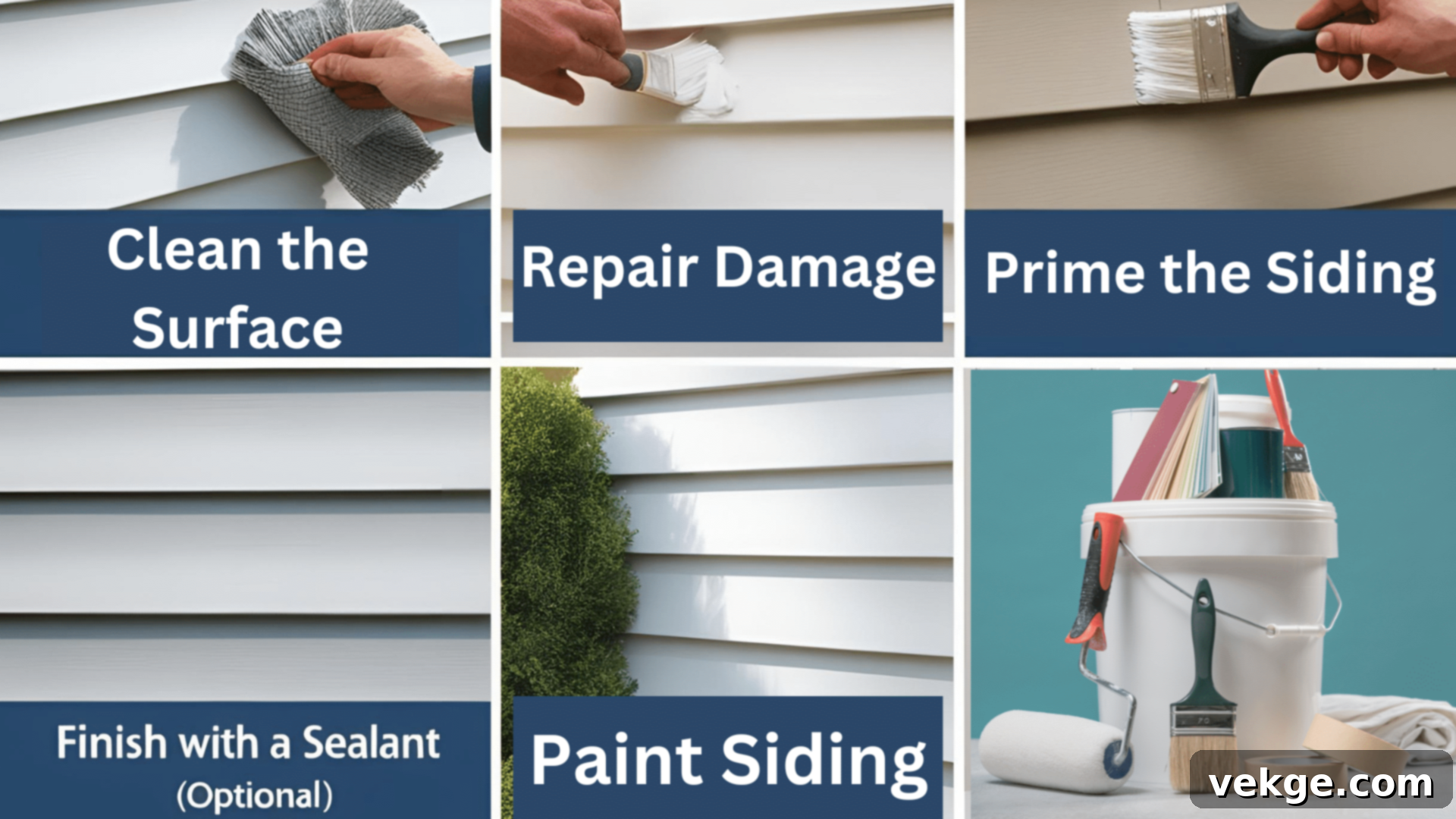
Painting aluminum siding is a highly effective and cost-efficient method to refresh your home’s exterior without the significant expense of a full replacement. With meticulous preparation and proper application techniques, you can achieve durable, professional-looking results that will protect your home and enhance its curb appeal for years. Follow this comprehensive guide to transform your aluminum siding with confidence.
Step 1: Thoroughly Clean the Surface
The success of your paint job hinges on a perfectly clean surface. Begin by thoroughly washing the aluminum siding with a mild detergent and water. For stubborn grime, mildew, or a chalky residue (common on older aluminum), a pressure washer is highly effective. If using a pressure washer, maintain a safe distance (at least 12-18 inches) and use a wide-angle nozzle to avoid damaging the siding.
For persistent chalking, mix Trisodium Phosphate (TSP) with water according to manufacturer instructions and scrub the surface with a stiff brush. TSP is a powerful degreaser and cleaner, excellent for removing the powdery oxidation layer. Always wear protective gear (gloves, eye protection) when using TSP. After scrubbing, rinse the entire surface completely and meticulously to remove all cleaner residue. Allow the siding to dry for a minimum of 24-48 hours, or until completely dry to the touch. Any moisture trapped beneath the paint can lead to blistering and peeling.
Step 2: Repair Any Damage
Once the siding is clean and dry, inspect it carefully for any imperfections. Fill small holes, cracks, or minor dents with an exterior-grade, flexible filler or automotive body filler specifically designed for metal. Apply the filler smoothly with a putty knife. Once dry, sand the repaired areas flush with the surrounding surface to ensure a seamless finish. For larger dents, a more extensive repair or even panel replacement might be necessary, though small imperfections can often be masked.
Use aluminum foil tape for very minor punctures. For gaps around windows, doors, or at seams, apply a high-quality acrylic latex caulk with silicone. This not only improves aesthetics but also seals the home against moisture intrusion, preventing future water damage and drafts. Proper repairs are essential for a uniform paint surface and to prevent moisture from compromising the paint job.
Step 3: Prime the Siding
Do not skip this critical step! Priming ensures superior adhesion of the topcoat, blocks stains, and provides a uniform base for the paint. Apply a high-quality exterior bonding primer specifically formulated for aluminum and metal surfaces. Look for primers that are rust-inhibitive and designed to adhere to challenging surfaces.
Apply the primer evenly. Use a good quality brush for edges, corners, and tight areas. For larger sections, a roller or an airless sprayer will provide the most efficient and uniform coverage. Sprayers are ideal for achieving a smooth finish quickly, but require proper masking of surrounding areas. Allow the primer to dry completely according to the manufacturer’s instructions, typically 12-24 hours. Rushing this step can lead to poor adhesion and premature paint failure.
Step 4: Paint the Siding
Now for the color! Choose a high-quality, 100% acrylic latex exterior paint specifically designed for metal or aluminum siding. Acrylic latex paints offer excellent durability, flexibility, and resistance to fading and chalking, crucial for exterior applications. They also dry faster and clean up with water.
Apply the paint with a roller, brush, or sprayer, ensuring even and consistent coverage. For the best, most durable finish, two thin coats are almost always superior to one thick coat. When using a roller, opt for a nap size appropriate for smooth surfaces. If spraying, ensure an even spray pattern and overlap each pass slightly. Work in manageable sections, maintaining a “wet edge” to prevent visible lap marks. Allow adequate drying time between coats, typically 4-6 hours, depending on temperature, humidity, and paint type. Avoid painting in direct, intense sunlight, as this can cause the paint to dry too quickly, leading to brush marks or poor adhesion. Similarly, check the weather forecast and avoid painting if rain is expected within 24-48 hours.
Step 5: Finish with a Sealant (Optional)
While often optional, applying a clear sealant can provide an extra layer of protection, particularly beneficial in harsh climates with extreme weather conditions or intense UV exposure. This step can extend the life of your paint job and maintain its fresh appearance for even longer.
Apply the sealant only after the final paint coat has fully cured, which usually takes 48-72 hours. Use a clear acrylic sealer specifically designed for exterior applications. Apply it evenly with a sprayer for the best, most uniform coverage. This additional protective layer helps guard against UV degradation, prevents premature fading, and provides an added barrier against moisture and environmental pollutants, significantly enhancing the longevity and beauty of your freshly painted siding.
Key Benefits of Painting Aluminum Siding
Painting your aluminum siding is more than just a cosmetic upgrade; it’s a smart investment in your home’s longevity and value. Here’s a closer look at the compelling advantages:
1. Significantly Improved Curb Appeal
- A fresh coat of paint can dramatically enhance the visual appeal of your home, making it appear more modern, vibrant, and meticulously maintained.
- It transforms faded, chalky, or discolored aluminum into a smooth, vibrant, and polished surface, instantly boosting your home’s aesthetic charm.
- The inherently smooth texture of aluminum siding allows paint to create a sleek, contemporary finish that looks clean and refined, elevating your property’s overall presentation.
2. Enhanced Protection and Durability
- Painting adds a crucial protective barrier to the aluminum, safeguarding it from oxidation, rust, and the relentless wear caused by harsh weather conditions, including UV radiation and extreme temperatures.
- The paint forms a waterproof and weather-resistant shield, protecting the siding from moisture penetration, which can lead to structural damage and mold growth.
- It actively prevents further fading and chalking, and a quality paint job can effectively seal minor gaps or imperfections, offering an additional layer of defense against water damage and extending the life of your siding.
3. Cost-Effective Home Update
- Painting is exponentially more affordable than completely replacing your aluminum siding, offering a high-impact transformation at a fraction of the cost.
- You can achieve a completely fresh, updated, and modern look for your home without the substantial financial burden and material waste associated with new siding installation.
- This approach delivers dramatic visual results and renewed protection for a modest investment, making it one of the most budget-friendly renovation options with an excellent return on investment.
4. Unlimited Personalization and Style
- Painting grants you complete freedom to choose any color that perfectly matches your home’s architectural style, your personal taste, or the surrounding landscape.
- You can easily coordinate your home’s exterior with landscaping elements, outdoor décor, or the overall aesthetic of your neighborhood, creating a cohesive and harmonious look.
- This offers a unique opportunity to completely redesign your home’s exterior, allowing for modern color choices that reflect your individuality and give your property a truly custom feel.
Expert Tips for Painting Aluminum Siding
Achieving a professional and long-lasting finish when painting aluminum siding requires attention to detail and adherence to best practices. These expert tips will help ensure the success and durability of your project.
Choose the Right Paint and Primer
Always use a premium-quality exterior paint specifically formulated for metal surfaces. Look for 100% acrylic latex exterior paint, often labeled for use on aluminum or vinyl siding. These paints are engineered with additives that enhance adhesion to challenging surfaces like metal, offer superior flexibility to withstand temperature changes, and resist the chalking and fading commonly associated with aluminum.
Equally important is the primer. Select a high-quality bonding primer designed for exterior metal, preferably one that is rust-inhibitive. While premium paints and primers might have a higher upfront cost, they typically require fewer coats, offer better coverage, and provide significantly longer-lasting results, making them a more economical choice in the long run. Consider the sheen level as well: satin or eggshell finishes are popular for exteriors, offering a subtle gleam and good durability, while flat finishes can hide imperfections better but may be harder to clean.
Don’t Rush the Process
Patience is paramount in painting, especially for exterior projects. Allow each coat of primer and paint ample time to dry properly according to the manufacturer’s instructions. Rushing between coats can severely compromise adhesion, lead to streaking, uneven coverage, and ultimately result in a less durable finish that peels or flakes prematurely.
Drying times can vary significantly based on temperature, humidity, and paint thickness, typically ranging from 4 to 24 hours. Always check the product label for specific recommendations. Ensuring sufficient drying time, particularly between the primer and the first topcoat, is crucial for maximum bonding and a uniform, professional appearance that will stand the test of time.
Be Mindful of the Weather
Weather conditions play a critical role in the success and longevity of your paint job. Avoid painting in extreme temperatures (too hot or too cold) or when rain is expected within the next 24-48 hours. Ideal painting conditions are typically mild and dry, with temperatures between 50-85°F (10-30°C) and moderate humidity (below 70%).
Excessively hot conditions can cause paint to dry too quickly, leading to brush marks, poor flow, and blistering. Cold temperatures can prevent paint from curing properly, affecting its durability and adhesion. High humidity can prolong drying times and lead to uneven finishes or mildew growth. Wind can blow debris onto wet paint and cause uneven drying. Always check the extended weather forecast before starting your project to ensure a clear window for preparation, painting, and adequate curing time for the final coat.
Why You Should Consider Painting Your Aluminum Siding Today
When evaluating home improvement projects, painting aluminum siding consistently offers one of the best returns on investment in terms of visual impact relative to cost. This straightforward yet transformative project delivers both immediate aesthetic benefits and long-term protection for your home’s exterior, making it an undeniable consideration for any property with aging aluminum siding.
Affordable Transformation: A New Look for Less
If your siding appears tired, faded, or simply outdated, painting presents an incredibly simple and low-cost solution that yields dramatic results. Compared to other exterior renovation options, such as replacing the siding entirely, painting aluminum siding offers exceptional value for a modest investment. The visual transformation can be so profound that neighbors and visitors might genuinely believe you’ve installed brand-new siding, not just a fresh coat of paint.
This perception of a major upgrade not only significantly increases your personal enjoyment of your home but can also boost its market value, making painting an excellent pre-sale project for homeowners planning to list their property. It’s an investment that pays dividends in both personal satisfaction and potential financial returns.
Long-Lasting Results with Minimal Upkeep
When properly prepared and painted with high-quality materials, freshly painted aluminum siding can maintain its beautiful appearance and protective qualities for many years with minimal upkeep. A professional-quality paint job typically lasts 5-10 years, and often longer, before requiring a refresh. This longevity depends on factors such as local climate conditions, the quality of paint and primer used, and the thoroughness of the initial preparation.
The inherent durability of aluminum combined with a protective paint layer makes painting one of the most sustainable and economical choices for exterior home improvement. Simple annual cleaning with a mild detergent and water is usually all that’s needed to extend the life of the paint job even further, ensuring that fresh, well-maintained appearance endures.
Conclusion
Painting your aluminum siding is a powerful and affordable strategy to dramatically enhance your home’s appearance while simultaneously providing long-lasting protection against the elements. By meticulously choosing the right materials, diligently following each preparation and application step, and committing the time required for proper execution, you can enjoy a stunning, beautifully maintained exterior for years to come.
This seemingly simple update has the potential to completely transform your home’s curb appeal, adding significant value and fresh character, all without the considerable cost, hassle, and disruption associated with a full siding replacement. Embrace the benefits of improved aesthetics, enhanced protection, and the endless possibilities for personalization that come with a freshly painted home. It’s a home improvement project that truly delivers exceptional value and enduring results.
